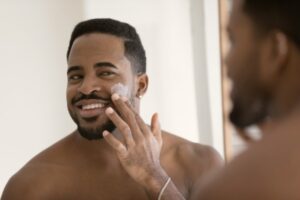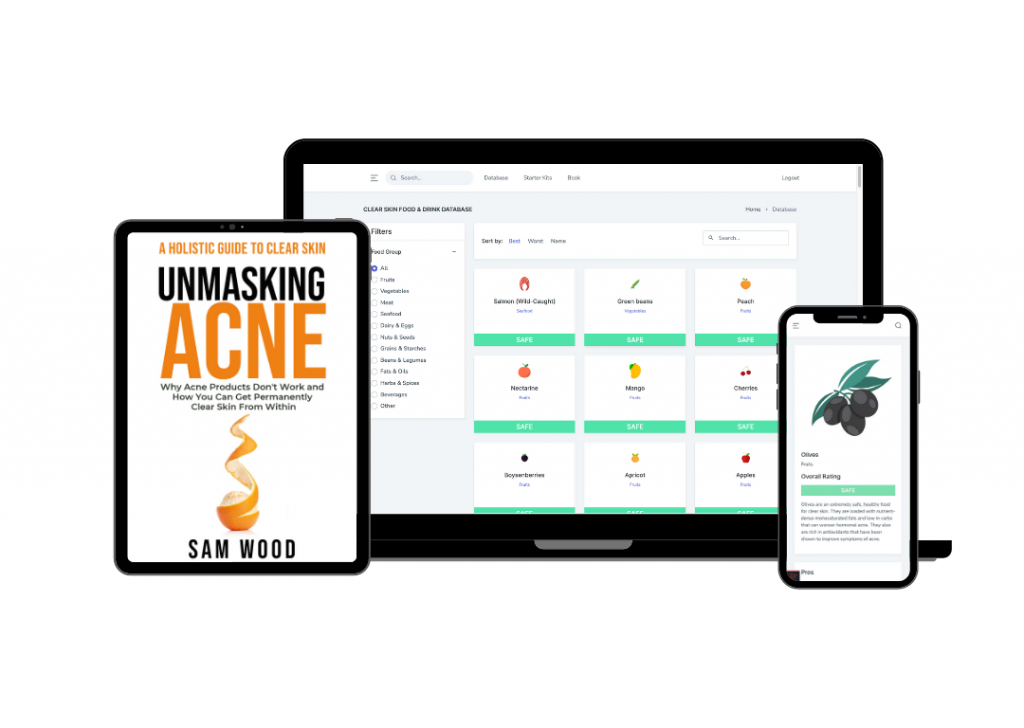I’ve gotten several questions from readers about various moisturizing tips, and on how to cultivate the best anti-acne skincare routine without inadvertently causing breakouts. One question I’ve seen popping up recently is about hydration, and whether or not you should apply moisturizer on a wet or dry face. Hydration is absolutely essential for keeping down oil production in acne-prone skin, so today I decided to write an article about moisturizing acne-prone skin, the right way.
In this article, I’m going to explain how to moisturize your skin to get the best out of your skincare products, whether to apply moisturizer on wet or dry skin, and how to keep acne-prone skin hydrated while keeping breakouts at bay.
Although a good moisturizing routine will increase overall skin health and can clear up some types of acne the best thing you can do for your skin is eat a healthy diet. As I explain in my guide Unmasking Acne, nothing works better for clearing your skin than treating it from the inside out with anti-inflammatory foods and steering clear of typically harsh, skin-stripping acne treatments.
Does Moisturizer Work Better on Wet or Dry Skin?
When it comes to applying moisturizer, you might have typically dried your face after cleansing and directly applied a moisturizer to your dry skin. While this might seem the most logical process, experts have recently touted the benefits of applying your moisturizer to a slightly damp face, typically around 3-5 seconds after cleansing or toning.
Why should I apply moisturizer to damp skin?
According to dermatologists, applying moisturizer to damp skin is the best way to ensure that your skin fully absorbs the topical ingredients in the product: the skin is more receptive when slightly damp, so applying a moisturizer directly after cleansing is the best way to ensure that your skin gets the full benefits of the product.
How damp should my face be when applying moisturizer?
Your face shouldn’t be dripping wet when applying moisturizer – the best way to ensure maximum product absorption is to apply moisturizer to a damp face, which is typically around 3-5 seconds after cleansing.
Should I dry my face after cleansing?
You can lightly pat your skin to get rid of any excess water from cleansing, however if you incorporate a toner into your skin routine, the best time to moisturize is directly after applying the toner to your skin. Toner will leave your skin slightly damp and enable your skin to soak up all the nourishing ingredients from your moisturizer. You can also moisturize your skin directly after coming out of the shower (if you prefer to wash your face in the shower), although not if your face is dripping wet – pat any excess water for 1-2 seconds, then apply your moisturizer.
How To Moisturize Skin To Avoid Acne
If you want to keep your skin supple, hydrated, and free from breakouts, try to adhere to the following instructions when choosing and applying a moisturizer to acne-prone skin:
Use a Moisturizer Without Comedogenic Ingredients
When it comes to applying products that sink into your skin (absorbent products such as creams, oils and toners) you’ll want to make sure that the ingredients are non-comedogenic. Comedogenic ingredients can clog your pores and cause breakouts to erupt all over your skin, typically in the form of whiteheads but also in the form of cystic acne (if you’re already prone to cystic outbreaks.) Keep these types of breakouts at bay by using oil-free moisturizers and always checking the label before applying any manufactured moisturizer to your skin.
Try Moisturizing With Natural Oils Instead of Creams
As acne sufferers, we’re almost conditioned to keep any type of oil at a minimum arm’s length from our skin. However, some natural oils are actually beneficial in helping acne: oils such as black seed oil, jasmine oil and safflower oil can help stabilize your skin’s oil production while providing nourishing benefits such as omegas 3 and 6, vitamin E, B and various amino acids. Certain natural oils work better than manufactured moisturizers when it comes to hydrating acne-prone skin: the amino acids and calcium in certain oils protect the skin’s oil barrier and prevent the skin from overproducing sebum.
Avoid Skincare Products With Lots Of Chemical Ingredients
When it comes to treating acne-prone skin, it’s best to keep things simple. When it comes to hydration, you can try skincare oils, or simply opt for moisturizers without any heavy, clogging ingredients. You’d be surprised how many supposed acne-fighting skincare products are full of pore-clogging oils and inflammatory ingredients.
Apply Moisturizer To Damp Skin
To finalize your skincare routine, make sure to apply your moisturizer to slightly damp skin for the reasons I explained above, ideally a couple of seconds after cleansing or directly after toning. If you have other skincare products or prescribed acne treatments to apply to your skin (meaning that you can’t directly apply moisturizer to damp skin) then you can always spray some hydrating face mist over your skin to keep it from drying completely. This is especially important if you suffer from dry or flaking skin. If you are dealing with a combination of dry skin and acne breakouts I recommend trying Mandelic acid to help nourish the skin barrier. One of my favorite Mandelic acid products for dry skin can be purchased from the Ordinary.
Try Using Hyaluronic Acid on Acne Prone Skin
If you’re looking for a super hydrating serum for acne-prone skin, hyaluronic acid is a great alternative to other more chemical serums and can provide essential hydration without clogging your pores. Hyaluronic acid can hold up to 1000 times its weight in water and is completely non-comedogenic, meaning that it won’t cause breakouts when applied directly to the skin. Hyaluronic acid is also a great serum to apply before applying moisturizer, as the hyaluronic acid will leave your skin a little damp, meaning that not only will your skin better absorb your moisturizer, but as hyaluronic acid is a humectant, it will hold moisture in your skin
My Verdict: Should I Apply Moisturizer To A Wet Or Dry Face?
If you want to get the most out of your skincare products, the best way to apply moisturizer is around 3-5 seconds after cleansing or toning. The skin will better absorb the active ingredients in your product and will be even more effective when combined with an acne-friend oil or serum.
However, it’s still important to remember that having an effective skincare routine is not the only step when it comes to clearing your skin and combating acne. If you’ve been trying for years to clear your skin and nothing appears to be working, you might want to investigate what’s causing your breakouts and get to the source of the problem. As I explained in Unmasking Acne, sometimes acne sufferers aren’t dealing with typical hormonal acne or cystic acne but are suffering from underlying health conditions which cause acne, such as fungal acne and candida. While your skincare routine will play an important role in the overall condition of your skin, the best way to overcome your acne is to treat it at the source.

